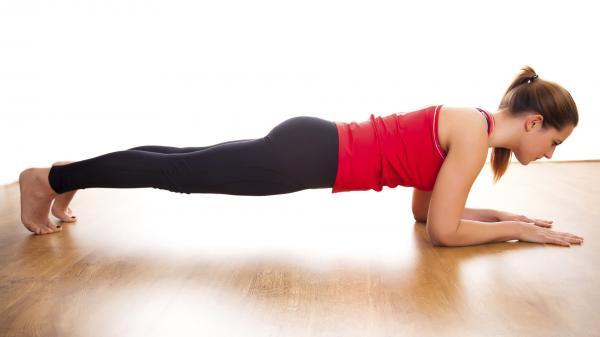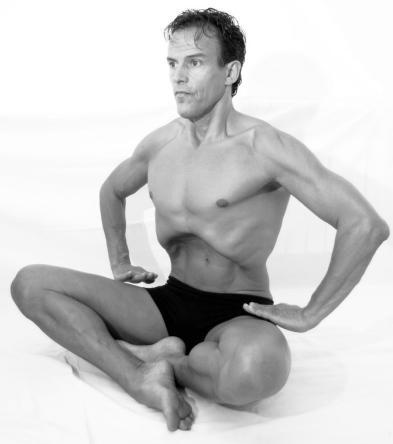
Hypopressive exercises were developed by Marcel Caufriez, a doctor who concluded that in certain circumstances, standard core abdominal exercises could result in incontinence issues or sexual dysfunction. Noticing a difference in breathing from the diaphragm on the pelvic area, his conclusion was that lowering the pressure in the abdomen could increase tonality and strengthen core muscles. Doing so would lessen the likelihood of incontinence and other complications from traditional pelvic floor exercises. The aim is the same as traditional sit-ups (i.e. reducing abdomen fat) while minimizing the risks mentioned above. oneHOWTO has the step-by-step guide to show you hot to do hypopressive exercises.
To follow the hypopressive method, you need to look after your posture and breathing. As hypopressive exercises work to reduce pressure in the abdominal area, they are sometimes referred to as low pressure exercises and a technique known as low pressure fitness was created using hypopressive exercises as a base. As opposed to other abdominal and core strength exercises, hypopressive exercises use breathing itself as the fundamental base to strengthen the area. Using your diaphragm during breathing to exercise these muscles might also lessen the possibility of certain conditions like hernias as you do not exert as much physical strain.
Once the postures explained below have been adopted, you have to inhale through the nose and exhale through the mouth calmly to work out the diaphragm. You'll notice that this will make your abdomen contract and your chest expand, something that wouldn't happen normally. This is because you are working your diaphragm thanks to the postures we explain below.
One of the reasons diaphragmatic breathing strengthens the abdomen more is due to slow twitch muscle fibers. Slow twitch muscle fibers are types of muscles which are more efficient at using oxygen and therefore help us with endurance and preventing fatigue. It is a combination of diaphragmatic breathing and apnea which helps get this effect. Apnea is a cessation in breathing (something which can be dangerous if it occurs during sleep) and holding your breath during hypopressive exercises will tone your abs as well as lifting up internal organs. This contracts the pelvic floor muscle while lessening the pressure put on them.
After inhaling deeply, you need to exhale while expanding the ribcage at the same time. This is counterintuitive as normally the opposite happens when breathing out. After exhalation, but with the rib cage still expanded, you perform the apnea (temporary cessation of breathing) and the hypopressive exercises exert their lowered pressure on the abdomen and pelvic area. This gives the abdomen its characteristic contracted belly and expanded ribcage appearance. Once you get these basics down, you can use a variety of different motions to strengthen the abdomen, pelvic area and perineum.

Before we get into our different hypopressive techniques, we will detail some of the advantages this type of low pressure exercise can give:
- Preventing prolapse: it was during examination of a patient with uterine prolapse that Dr. Caufriez discovered the importance of breathing from the diaphragm. A prolapse is when an organ falls or slips out of its usual place. Exercising after birth can lead to women suffering prolapse as additional strain on an already strained area can lead to uterine or even rectal prolapse. As hypopressive exercises do not put as much pressure on these areas, some doctors recommend it as an alternative way to exercise after childbirth.
- Improves breathing and respiratory function: the deep breathing and chest expansion of hypopressive exercises can help overall respiratory function.
- Decreases waistline: can be useful for those who are on a weightloss program as continued practice along with a balanced diet has been known to decrease waistlines.
- Preventing incontinence: incontinence can happen for numerous reasons, but it is also exacerbated by age. This is why hypopressive exercises can be useful for those of an advanced age to practice as it helps prevent leakage.
- Improving posture and preventing hernia: hypopressive exercises help with postural muscles without straining lumbar muscles which can cause hernias.
- Improves sexual function and performance: just as training your legs can make you a better runner, training using hypopressive exercises can lead to muscle tone of the vaginal area which can lead to greater pleasure during sex.
Hypopressive exercise techniques
Now, we're going to show you an easy hypopressive exercise that will help tone your abdomen and show it off firm and fat-free. Here's a step-by-step guide to do it properly:
- Stand up with your feet totally parallel to each other.
- Flexing your knees, put your hands on them.
- Tuck your chin towards your neck and let the weight of your body fall on your feet.
- Breathe deeply trying to open your rib-cage as much as possible. Hold your breath for 10 seconds between each breathe in and out.
The best thing to do is try 3 series of breaths and then, continue to the next hypopressive exercise that will keep you working on the area.

The next exercise you can incorporate to your hypopressive exercise routine is called the "plank exercise". This is a method in which the abdomen muscles are working, as well as the back, glutes, legs, and the whole body. In fact, this is a very popular exercise among people who want to sculpt their body as much as possible.
- Go on all fours leaning your body on the floor with your forearms and the tips of your toes. The elbows must be in parallel line with your shoulders and your back should be relaxed in order to prevent injuries.
- Make sure your body is in a perfect line and hold this position. Your body should be parallel to the floor with your abs completely stretched.
- Hold the position for 5 minutes breathing deeply.
If it's your first time doing this hypopressive exercise, we recommend you start practicing progressively. Hold for 2 minutes, rest for 1 and try 2 more minutes. The longer you can hold in this position, the more toned your abs will be. This slower form of exercise will increase slow muscle fibers and improve stamina.
Foto: rougeframboise.com

Now we're going to show you another hypopressive exercise that is known as "the Taylor". To do this exercise, follow these steps:
- Sit down on the floor with your legs folded.
- Keep your back straight and place your arms on your hips.
- Start taking deep breaths, holding your breath for ten seconds after breathing in and out each time.
Three series of this exercise will help you work on your abs. This is also a great postpartum hypopressive exercise as it can help tone your body after the loosening effects of pregnancy and childbirth.

The last exercise we suggest will help you work on your abs thanks to hypopressive breathing. In this case, you need to lie on the floor:
- Lie down face-up, flexing your knees slightly.
- Your heels should be leaning on the floor while the rest of your foot should be lifted (this is known as dorsiflexion).
- Flex your arms and place them at your stomach's height, facing upwards.
- Auto-elongate and push your chin towards your neck.

In order to do hypopressive exercises correctly, you should take some things into account so you can get the right position and technique at home. Let's go over the vocabulary of the hypopressive method:
Auto-elongation
Stretch your back as much as possible, putting strength on your bones and muscles, as if you wanted to grow taller.
Double chin
Push your chin downwards, as if you wanted to touch your throat with your chin. This will allow you to stretch your spinal column and achieve the basic position to do hypopressive exercises.
Deep breaths
It's also essential to take very deep breaths, feeling how your lungs fill with air completely. You must keep them full for around 10 seconds approximately.
Apnea
This is the moment when we exhale air. It should be done slowly and evenly until you feel your lungs are completely empty and there is no air left.
Tucking the abdomen
It's essential to tuck your abdomen in, as if you were hiding your stomach to do these exercises. This way we separate our ribs and exercise you stomach's muscles.

If you want to read similar articles to How to Do Hypopressive Exercises, we recommend you visit our Fitness category.
- It is advisable to get help from a professional before practising hypopressive exercises. The technique is complicated and it can cause injuries if done wrongly.